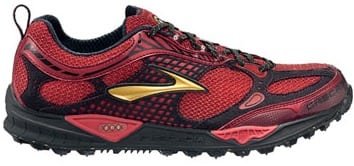Twice each year, the US outdoor industry gathers in Salt Lake City’s Salt Palace to take a look at the coming year’s product line up. For example, many spring/summer 2011 debuted at the 2010 Outdoor Retailer Summer Market (ORSM). As has become tradition, we’re giving our take on these forthcoming products well after the August show, but before the January/February release of many of these products. Below are some of our favorite traditional trail running shoes from the show. There’s a separate article on minimalist shoes from the show and there will be a third post regarding other products that caught our eye. Now, let’s bring on the shoes!
Salomon XR Crossmax Neutral and Guidance ($130)
The Salomon XR Crossmax Neutral is out favorite new hybrid or door-to-trail shoe as Salomon prefers to classify it. I’ve run a great deal in the Crossmax Neutral and it performs quite well on both trail and roads. Well enough, in fact, that I recently ran a 50 mile race having never previously worn the Crossmax for more than 8 miles. Now, that’s trust.
With the Crossmax, Salomon focused on fit, ride, and grip. While the upper combines a few fabrics (and fabric technologies), Salomon tried to limit the amount of stitching. The combination of materials provide a very comfortable, reasonably breathable upper. We’ve found the XT Wings 2 to be quite capable on the roads, but this is another step up. For Salomon’s first attempt to make a shoe that’s as good on roads as the trails, they really nailed the ride. There’s a great heel-toe transition, if you’re into that sort of thing. The outsole is chevron-centric, which provides a solid mix of surface area for the road as well as forward and backward traction on the trails. You can also look for a gusseted tongue and Salomon’s QuickLace in both models. The Salomon XR Crossmax Neutral weighs 11.3 ounce (320 gram) for a US men’s 9 in this post-less shoe.
The XR Crossmax Guidance is essentially the same shoe as the Neutral version with the addition of five support or guidance features. First off, there’s medial posting to offer a bit of support. Second, there’s also more medial material to continue the support at the inside of each stride. Third, the OS Tendon in the midsole and outsole, which helps provides stability and rebound, is straighter than the curved design found in the Neutral version. Fourth, the upper of the Crossmax Guidance replaces much of the welded seems found in the Neutral with stitched seams. This gives the shoe a different fit. Finally, the Guidance upper has more Sensifit, a thin-welded overlay that helps provide structure to mesh in the forefoot. The Salomon XR Crossmax Guidance in a US men’s is 12 ounces (340 grams).
Brooks Cascadia 6 ($110)
There are few trail shoes for which we’re likely to cover every subsequent model. The Brooks Cascadia is one of them. This time around, there’s lots to report. Now in its sixth iteration, Brooks has chopped a full ounce off the Cascadia. While not heavy before, an 11.2 ounce (317 gram) version has us dreaming of running up Hope Pass in the Leadville 100. One addition to the Cascadia 6 is a fourth pivot post, this time in the inside of the forefoot. Another big change is that Cascadia 6 will include Brooks’ DNA “spontaneously adaptive cushioning.”
There are also changes to the upper, the most significant of which appears to be a metatarsal wrap to lock your foot in place. Another upper modification is the addition of a “tongue tie” that should help keep the tongue from migrating. Although the outsole is ringed by familiar lugging, the middle portion of the outsole is filled with 19 lugs each of which resemble a four-lobed version of a radiation symbol. The lug pattern, which has lower lugs in the forefoot, should shed mud better than previous versions.
Aside from the lugs and one colorway for both the men and the women… these shoes are far from radioactive. There are lots of environmentally friendly stories, such as a BioMoGo midsoles and recycled rubber in the outsole, but we’ll save those for another time. You’ll be able to check the shoe out yourself in February 2011.
The North Face Double-Track and Single-Track TH ($110 and $90, respectively)
The North Face made great strides in releasing the Single-Track last year. In the coming year, they plan to follow up on that success with the Double-Track. The Double-Track will be aimed at those who want more shoe than the Single-Track. It is more plush with lots more cushioning as well as some added stability. The Double-Track will feature an external cradle to provide a more secure heel fit without overly control the foot. It will weigh about the same as the Single-Track.
Inspired by athlete Lizzy Hawker, The North Face will be releasing the Single-Track T.H. (Terrain Harness). The main modification to the Single-Track TH model is the addition of a medial post for the runner who needs some pronation control. The aim of this shoe is not to be beefier. In fact, TNF removed the Snake Plate rockplate from the TH. Note, however, that this model does have more cushioning that the standard Single-Track.
Montrail Badrock ($100)
This is our favorite training-focused shoe (i.e., not the Rogue Racer) in Montrail’s Spring/Summer 2011 lineup… and we’ve run in every shoe in the lineup. It’s a solid mix of a runnable midsole/outsole package and comfortable upper. The highlight of the upper is a pleasantly roomy toebox. The midsole highlights Montrail’s new FluidPost technology. FluidPost blends pieces of different density EVA to provide variable support depending on the needs of the runner and terrain. The Badrock’s outsole is the same as found on the currently available Rockridge.
New Balance 915 ($120)
Aside from improving the MT101 and shaking things up with the Minimus line, New Balance is revamping its core performance trail line. The New Balance 915 will be a trail running shoe for the masses, but made with the philosophies of “what you see is what you get” and “less is more.” The 915 features a redesigned RockStop rockplate that’s more flexible than its predecessors. The midsole/outsole package has been simplified. So has the upper, which is quick drying with fewer overlays and a reduced toe bumper. The tongue will be gusseted. Compared to other projects that New Balance has been working on, the 915 may not seem like a big deal. However, it’s great to see an established company reflecting on its main trail running line and removing what’s not needed from those shoes.
Inov-8 F-Lite 311 ($110)
The F-Lite 311 is not a revolutionary development. It’s not really an evolutionary one, either, unless it’s convergent evolution. You see, Inov-8 ditched the F-Lite 301, 305, and 320 in favor of a single model of F-Lite trainer, the F-Lite 311. Yeah, the F-Lite series is touted as a parkour/urban running shoe, but we know some runners use the trainer range of F-Lites, as well. Here’s Inov-8 US team manager Mark Lundblad’s review of the F-Lite 311. [broken link to US Inov-8 team blogpost entitle “F-Lite311 Shoe Review by Mark Lundblad” removed]
For those who prefer Inov-8’s lighter F-Lite models, don’t worry. The F-Lite 195, 220, and 230 are still out there to fit your needs.
La Sportiva Quantum and Electron ($115 and $120, respectively)
We’ve already previewed La Sportiva’s MorphoDynamic technology that will be found in the forthcoming Quantum and Electron.
Oboz Lightning ($110)
The Oboz Lightning it a solid entry into the disappearing breed of rugged trail shoes. However, two key features make it unlike many old school members of this class: it’s relatively light weight (12.7 ounces for US men’s 9) and it has excellent runnability. We’d imagine this would be a great shoe in which to go cruise the Bridgers, Massanuttens, or any other rocky-strewn mountain range. That makes sense as in the post-Ignition world (the Ignition will be discontinued), as Oboz is focusing on protection and durability.
Call for Comments
Any of these shoes interest you? If so, which ones and why?










